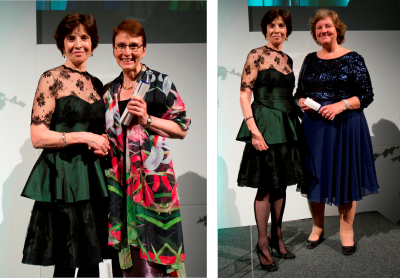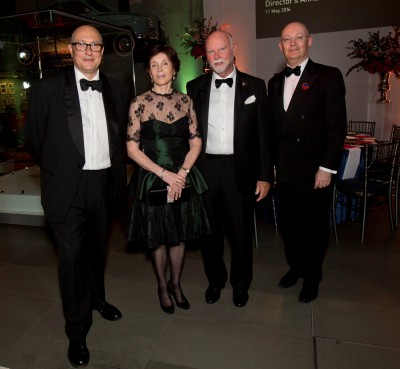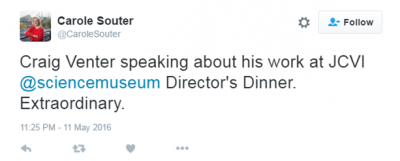A glimpse of how big data can make healthcare more proactive, preventative and predictive was given by the world’s best-known biotechnology entrepreneur, Dr. Craig Venter, last night at the Science Museum’s Director’s Annual Dinner.
Dr. Venter, who flew to the Museum from his home La Jolla and returns to Washington today, is the recipient from President Obama of the National Medal of Science, the highest honour awarded to scientists by the US government.
Dr. Venter recently set up Human Longevity Inc (HLI) to change the nature of medicine with big data, also the subject of a museum exhibition opening in July, Our Lives in Data.
HLI is analysing human DNA with the world’s largest DNA sequencing facility, which decodes a human genome every 15 minutes. In addition, it will study microbiomes, the DNA of gut microbes, which play a key role in health and gather data about phenotypes: patient behaviour, physiology, and anatomy, notably with MRI body scanning.
Using machine learning and spending $1 million every month on cloud computing to analyse these data, Dr. Venter wants to make a decisive shift in medicine, from treatment to prevention.
The Science Museum audience was held spellbound by his account of a series of dramatic case histories in which HLI diagnosed rare conditions, provided advance warning of disease and helped customise treatments.
They were also given a demonstration of how DNA can be used to predict eye colour, facial features, skin tone, height, age and more. He added: ‘We think we can predict, fairly accurately, when you might die.’
Dr. Venter has a record of innovation which dates back to the 1990s when he came up with a nimble way to find genes, then unveiled the first complete DNA sequence of a free-living organism, the bacterium Haemophilus influenzae.
He became global front page news in June 2000 when his privately funded company Celera unveiled its first human genome alongside the publicly funded version in the White House. In 2007, he published the first complete genome of an individual human – his own genetic code .
He set up the J. Craig Venter Institute, which has the first carbon neutral lab in La Jolla, and co-founded Synthetic Genomics, a firm dedicated to using modified microorganisms to produce clean fuels.
He described to the audience how he left his signature in the form of a DNA watermark in the world’s first synthetic organism, even its URL and email address, and has also ‘changed the software of life to change the species’.
Dr. Venter recently figured out the minimal number of genes to create an organism with just 473 genes, of which one third are of unknown biological function. He has launched a competition for students to adapt this minimal cell, ‘recapitulate evolution’ and see who can ‘add the biggest evolutionary step.’
Earlier Science Museum Group Director (SMG), Ian Blatchford, told the distinguished audience about the year’s highlights for the Science Museum, which was the most Googled museum on the planet in 2015.
They included opening of the world’s oldest horological collection, the Clockmaker’s Museum; hosting 4,000 schoolchildren to count down to Tim Peake’s launch on his Principia mission; and the news that the museum’s exhibition about particle physics, Collider, has now been seen by more than half a million people on its world tour. “I joked at the original opening that we would show how ‘achingly glamorous’ particle physics can be and so how appropriate that the final venue will be the dashing Museum of Tomorrow in Rio.”
He announced the transfer to Moscow of Cosmonauts: Birth of the Space Age, which was described by The Times as the ‘best space exhibition ever’.
Treats to come include the most comprehensive exhibition ever on Robots, launched with a Kickstarter campaign to rebuild an iconic British robot; the new Mathematics Gallery, designed by late and great Dame Zaha Hadid and the next generation of science learning galleries with £6m of investment – most of it from new corporate supporters. ‘There will be joy in physics, engineering and (for the first time) in maths and chemistry too,’ he said.
After SMG Chairman, Dame Mary Archer thanked Dr Venter for his speech and awarded distinguished guests Science Museum Fellowships.

The first is Professor Dame Ann Dowling, Order of Merit, the first female professor in Cambridge’s Engineering Department, and the first female President of the Royal Academy of Engineering, which has worked with the museum on Engineer Your Future – seen by over 700,000 people since it opened in December 2014.
The second is Dr. Helen Sharman, now at Imperial College London, who also notched up two remarkable firsts when, in 1991, she became the first Briton to go into space and the first woman to visit the Mir space station. Helen will be marking the 25th anniversary of her flight next week.
Dame Mary also told the audience about our own Northern Powerhouse – our museums in Manchester, Bradford, and York. Manchester will create a major new gallery – Cottonopolis – to tell the story of Manchester as the world’s first industrial city.
‘In July we’ll be opening a nano-sized exhibition – Wonder Materials – exploring the potential of graphene, the extraordinary two-dimensional material identified at the University of Manchester by Nobel Laureates Andre Geim and Kostya Novosolev.’
Dame Mary said the headline news of the year for National Railway Museum (NRM) was the triumphant return of Flying Scotsman to the rails after a ten-year programme of restoration. Further north, the NRM at Shildon also had cause for celebration with its two millionth visitor, “quite remarkable after only eleven years of operation of a museum that was expected to get a modest 40,000 visitors a year.”
“Meanwhile, more visitors are coming through the door at our National Media Museum in Bradford, where a much clearer focus on STEM subjects – science, technology, engineering, and mathematics – is enabling us to explore our collections in new ways.“

The MC of the event was the SMG Director of External Affairs Roger Highfield and other guests included Trustees David Willetts, Lords Grade, and Faulkner, Professor Dame Athene Donald; Ms Sharon Flood; Professor Russell Foster; Anton Valk and Dame Fiona Woolf.
Also present were photographers Jonathan Anderson and Edwin Low; Sarah Main of the Campaign for Science and Engineering; double Oscar-winner Paul Franklin; Marcus du Sautoy of Oxford University; Gail Cardew of the Royal Institution; Astronomer Royal, Lord Rees; Howard Covington of The Alan Turing Institute; cage fighter Jack Kreindler; Lucie Green of the Mullard Space Science Laboratory; and John Womersley of STFC.
The Science Museum Group is grateful for the opportunity to recognise and thank our funders and partners.
